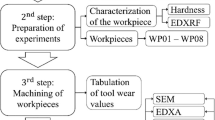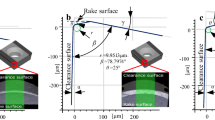Abstract
The wear of the tungsten carbide–cobalt (WC/Co) micropunch (150 μm diameter) and its effects on the microhole morphology in various periods of processing were investigated. Punching was performed using titanium as substrate. Effects of the punch number on the weight loss and the surface morphology of the micropunch had been studied by confocal microscopy, scanning electron microscopy, energy-dispersive X-ray analysis, etc. The morphology of the punched microholes had also been investigated correspondingly. Results showed that the micropunch underwent distinct wear loss during the initial period of micropunching, which was linked to loss in Co. The diameter of the punched microholes was changed accordingly and some debris on the surface of the hole was observed. Then, the punch entered a period of quasi-stability: there was very little wear loss and the diameter of the punched holes was rather stable. The wear rate of the micropunch increased remarkably when the punch number exceeded about 1,500. The wear loss was due to loss in both Co and WC. Large bulk debris was attached to the punched hole, and the diameter of microholes was changed correspondingly. Further increase in the punch number showed more drastic punch wear, debris attachment, and hole's diameter reduction. The dominant was then mainly in WC.
Similar content being viewed by others
References
Fecht HJ, Werner M (2004) The nano-micro interface: bridging the micro and nano worlds. Wiley-VCH, Weinheim
Mark JJ (2006) Microfabrication and nanomanufacturing. CRC/Taylor & Francis, Boca Raton FL
Christophe G (2003) Microsystems engineering: metrology and inspection III. SPIE, Bellingham Wash
Madou MJ (2004) Microfabrication challenge. Anal Bioanal Chem 378:11–14
Knobloch H, Kaminorz Y (2004) MicroNano integration. Springer, Berlin Heidlberg
Mohamed GH (2006) The MEMS handbook. CRC/Taylor & Francis, Boca Raton FL
Oliver G, Henning K, Pieter T (2004) Microsystem engineering of lab-on-a-chip devices. J Angewandte Chemie 43:4382–4390
Johnstone RW, Parameswaran M (2004) An introduction to surface-micromachining. Kluwer, Netherlands
Edwards SA (2006) The nanotech pioneers. J Angewandte Chemie 45:7116–7117
Haberstroh E, Hoffmann WM, Poprawe R, Sari F (2006) 3 laser transmission joining in microtechnology. J Microsyst Technol 12:632–639
Smolka G, Gillner A, Bosse L, Lützeler R (2004) Micro electron beam welding and laser machining—potentials of beam welding methods in the micro-system technology. J Microsyst Technol 10:187–192
Luo SY (1999) Effect of the geometry and the surface treatment of punching tools on the tool life and wear conditions in the piercing of thick steel plate. J Mater Process Technol 88:122–133
Bahloul R, Ayed BL, Potiron A, Batoz JL (2010) Comparison between three optimization methods for the minimization of maximum bending load and springback in wiping die bending obtained by an experimental approach. Int J Adv Manuf Tech 48:1185–1203
Delpozo D, López de Lacalle LN, López JM, Hernández A (2008) Prediction of press/die deformation for an accurate manufacturing of drawing dies. Int J Adv Manuf Tech 37:649–656
Mucha J (2010) An experimental analysis of effects of various material tool's wear on burr during generator sheets blanking. Int J Adv Manuf Tech 50:495–507
Joo BY, Rhim SH, Oh SI (2005) Micro-hole fabrication by mechanical punching process. J Mater Process Technol 170:593–601
Author information
Authors and Affiliations
Corresponding author
Rights and permissions
About this article
Cite this article
Guo, W., Tam, HY. Effects of extended punching on wear of the WC/Co micropunch and the punched microholes. Int J Adv Manuf Technol 59, 955–960 (2012). https://doi.org/10.1007/s00170-011-3567-0
Received:
Accepted:
Published:
Issue Date:
DOI: https://doi.org/10.1007/s00170-011-3567-0




